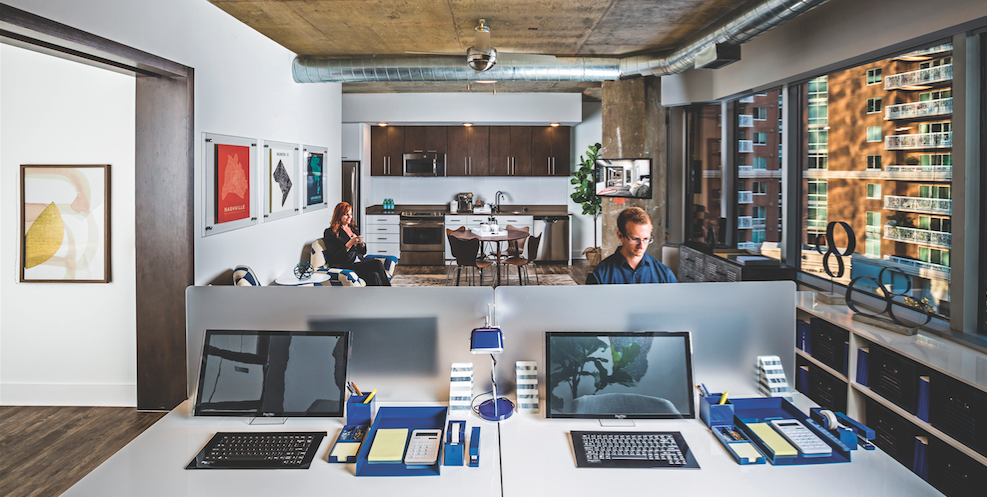The new e-lofts, a 200-unit complex now leasing in Alexandria, Va., owes its genesis to the smartphone. Thanks to our smartphones (and laptops and tablets) we no longer have to be tethered to our cubicles. We can work from practically anywhere. The Census Bureau says 6.8 million Americans—4.6% of the U.S. workforce—work from home. Global Workplace Analytics estimates that 20–25% of U.S. workers do so remotely part time.
The practical effect of the unshackling of the American worker is that traditional downtown and suburban office buildings are bleeding tenants. In Northern Virginia, which includes the city of Alexandria, there are about 150 office buildings with vacancies of 50,000 sf or more, according to the Washington Post. Office rentals in the metro area are flat, even as the region added 66,600 jobs last year.
About three years ago, Conrad Cafritz, Chairman/CEO of Cafritz Interests and the son of legendary Washington, D.C., real estate developer Morris Cafritz, pondered this disturbing scenario. His five decades’ experience in real estate told him that most of these structures were beyond salvation as office properties. Yet most of them were basically good buildings. They were usually in choice locations. They had been the trophy properties in their markets when they first opened their doors. Most had tons of parking, and they usually had “good bones,” structurally speaking. But time and technology had rendered them obsolete.
With all those plusses, Cafritz wondered, why couldn’t these properties be put to better use?
At some enlightened moment in his reverie, Cafritz hit upon a revolutionary idea. Most local jurisdictions in the D.C. area, he knew, permitted mixed-use buildings—office, retail, residential, even hotel—in certain zoning districts, as long as the respective uses were physically separated from one another.
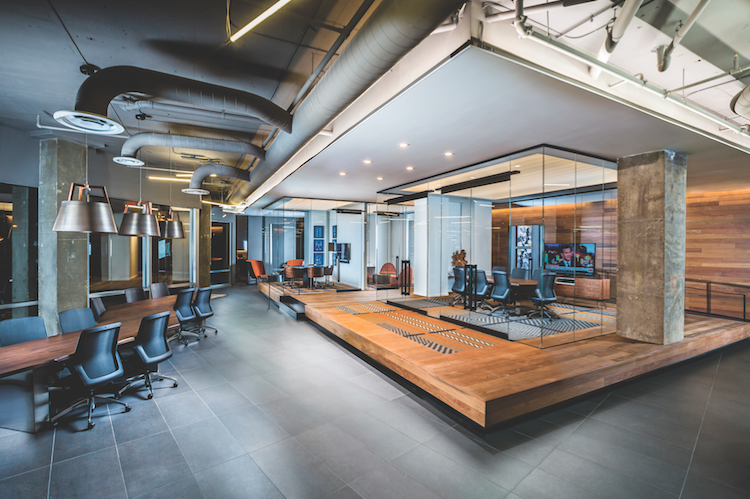 An elevated glassed-in conference room (280 sf, expandable to 410 sf) can be curtained for privacy. “The wood [ipe] brings in a warmer feeling,” says Gensler’s Joanna Shin. “We wanted to avoid a gritty-grungy startup feel, to balance high-end residential with commercial-corporate.” Area at left has workstations with undercounter power/data ports. Flooring: Basaltina stone tile
An elevated glassed-in conference room (280 sf, expandable to 410 sf) can be curtained for privacy. “The wood [ipe] brings in a warmer feeling,” says Gensler’s Joanna Shin. “We wanted to avoid a gritty-grungy startup feel, to balance high-end residential with commercial-corporate.” Area at left has workstations with undercounter power/data ports. Flooring: Basaltina stone tile
What if these old relics could be renovated to allow for three different kinds of uses—Cafritz called them “live,” “live-work,” and “work”? And not just in the same building but—and this was the genius stroke—on the same floor? That could be a game changer. Hundreds of vacant or distressed office buildings could be converted into properties that offered the lessee a choice of three options. Cafritz was well aware that no one in the Washington real estate market—maybe not in the whole country—had ever tried it, but that wasn’t going to stop him.
In 2015, he and Robert M. Seldin, CEO of Novus Residences, a multifamily partnership within Cafritz Interests, purchased a vacant 14-story office building near I-395 in Alexandria. The property, built in 1987, was assessed at $57.4 million; they got it for $20 million. They brought in Lord Aeck Sargent (architect), Gensler (interiors/visioning), and Landworks Studio (landscape design) to turn Cafritz’s vision into reality. Then they marched off to City Hall to plead their case to the local authorities.
REINTERPRETING THE ZONING
The newly acquired property was zoned for high-density mixed use. Both commercial office and multifamily residential were allowed, but only “in a single structure or multiple but integrated and related structures.” In other words, offices and living spaces had to be physically separated from each other.
The developer appealed to the city for a broader interpretation of the ordinance. Novus wanted to meet the needs of three target groups: couples who wanted lots of living space; work-at-home singles and couples; and small businesses of 10 employees or less, which, as Seldin told city officials, make up three-fourths of U.S. companies. Would the city allow a mix of these three uses on the same floor?
Robert Kerns, AICP, Alexandria’s Development Division Chief, says the city was intrigued with the idea, but had to tread carefully. “We’re both a regulatory agency and one that encourages economic investment in the city,” he says. But city officials had good reason to be open-minded. Alexandria already had “a lot of underutilized or vacant space,” says Kerns. The Novus concept might just be a way to turn some of those empty boxes into sorely needed housing and space for emerging businesses.
Negotiations went on (amicably, according to all parties) for several months.
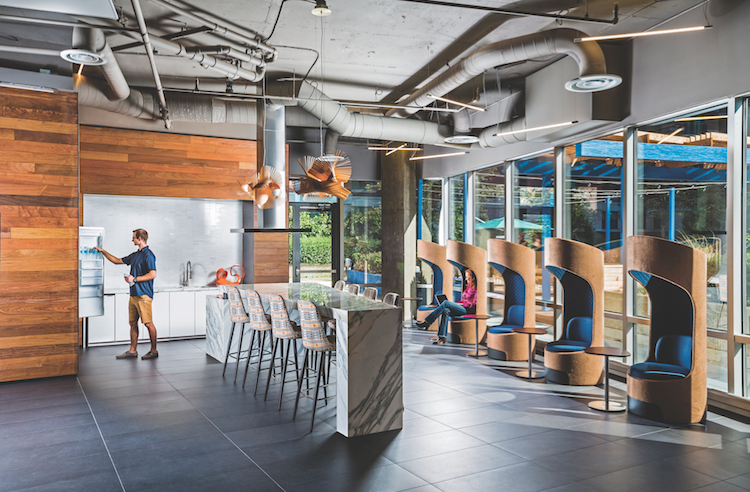 The fully equipped demonstration kitchen can host corporate events, celebrity chef demonstrations, or casual parties. The back door leads to the outdoor patio/grill area. The “lipstick chairs” (right) provide “cones of silence” for individual users. The design team skewed the grid to achieve spatial variety and visual interest.
The fully equipped demonstration kitchen can host corporate events, celebrity chef demonstrations, or casual parties. The back door leads to the outdoor patio/grill area. The “lipstick chairs” (right) provide “cones of silence” for individual users. The design team skewed the grid to achieve spatial variety and visual interest.
The city took the position that it was open to a reasonable interpretation of the “commercial/residential” language of the ordinance, provided all other zoning requirements—particularly as to parking and open space—were met. With 541 slots, the property more than complied with the parking requirements (five spaces per 1,000 sf of area). Counting the 30,000-sf deck roof on the parking structure as open space (OK under the ordinance), the property easily met the 40% open-space minimum.
“It was a new idea, and the city prides itself on being in the forefront of development trends,” says Kerns. “We felt they were meeting the zoning impacts.” But the decision would not reflect blanket city policy. It applied only to the e-lofts application, says Kerns. But as long as Novus strictly complied with the building code, no zoning variances would be required.
In the fall of 2015, the general contractor, Paradigm Contractors, was given the go-ahead to start demolition. E-lofts was on its way.
A SOLID BUILDING TO WORK WITH
The basic structure of the building had a lot going for it. “We wanted to take advantage of the 10-foot floor-to-ceiling heights and the expanse of the windows,” says Warren L. Williams, AIA, Principal, Lord Aeck Sargent. Ceilings and ductwork were purposely exposed for a high-tech effect. “We didn’t want to clutter things up,” he says.
The IT infrastructure that electrical subcontractor Cherry Lane provided is “very robust,” says Williams. There’s fiber optic service to every space, and easy access to power and data ports. Tenants can pipe right to their wiring closet and use it as a server room. “It’s a fat backbone,” says Williams. “They can use their own local area network or Novus’s.”
The 176 one-bed, one-bath loft units and 24 two-bed, two-bath lofts have 10-foot exposed ceilings, movable pocket walls, full-size washer/dryers, walk-in showers, soaking tubs, and Euro-style kitchens with pantries, quartz countertops, and bottom-drawer freezers.
The team did experience the occasional hiccup. “We had to go back a few times to the code officials to explain the concept behind mixing these spaces for both residential and commercial use,” says Joanna Shin, AIA, LEED AP, SEED, an Associate with Gensler. Because the huge windows were not operable, they had to pump up the fresh-air intake. Mechanical/plumbing contractor Hurst Engineers had to do a considerable amount of bath and kitchen work to make the original office spaces suitable for residences.
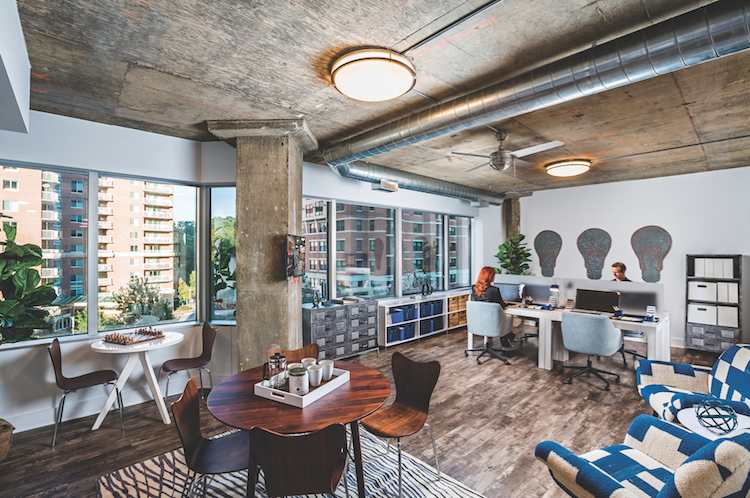 The loft-style one- and two-bedroom “live” or “live-work” units have 10-foot exposed ceilings, movable pocket walls, full-size washers and dryers, walk-in showers and soaking tubs, and Euro-style kitchens with pantries, quartz countertops, and bottom-drawer freezers. The “work” units have similar amenities, although the bedrooms are fitted for office use. Monthly rents run from $1,565 to $2,800 for one-bedrooms; two-bedrooms run $2,950/month.
The loft-style one- and two-bedroom “live” or “live-work” units have 10-foot exposed ceilings, movable pocket walls, full-size washers and dryers, walk-in showers and soaking tubs, and Euro-style kitchens with pantries, quartz countertops, and bottom-drawer freezers. The “work” units have similar amenities, although the bedrooms are fitted for office use. Monthly rents run from $1,565 to $2,800 for one-bedrooms; two-bedrooms run $2,950/month.
One place where they didn’t spend a lot of time or money: the façade. “The client wanted to put the emphasis on the interior,” says Shin.
On the exterior, the 30,000-sf parking garage roof gave Landworks Studio a chance to create a “cohesive experience, a living environment,” says Director of Design Mike Blier, ASLA, RLA, Hon. BSA. “It’s a kind of backyard, where we’ve programmed a range of amenities that everyone from individuals or couples up to large groups can enjoy.”
There’s a patio-with-pergola that leads to the indoor kitchen, a “beach” for lounging and sunbathing, and flex space for active sports like badminton, table tennis, or volleyball. “We used simple, honest materials, nothing too fancy,” says Blier. Catenary lighting lends what he calls “an outdoor living-room effect” to the environment.
The city issued final certificates of occupancy in December, and Novus has been averaging 20 leases a month since, says Seldin. “They’re exceeding the amount of nonresidential tenants that we anticipated,” says Kerns. “They’re getting a mix of uses. People are embracing the concept.”
Cafritz and Seldin have plans to invest $250 million in repurposing vacant office buildings into e-lofts. They’ve already spread the e-lofts gospel to neighboring Fairfax County, where they’re retrofitting a vacant office building into 156 e-lofts.
It took less than six months to convince Fairfax officials to change the zoning ordinance to allow as much as 100% residential in Planned Development Commercial Districts, up from 50%. To clinch the verdict, Seldin took Fairfax’s elected officials on a tour of the Alexandria e-lofts. “They were impressed,” he says.
PROJECT TEAM | E-LOFTS
Client: Novus Residences, LLC Architect: Lord Aeck Sargent Interior design/Visioning: Gensler Corridor Design: Carlyn and Company Interiors + Design Landscape architecture: Landworks Studio Structural engineer: Ellinwood + Machado Civil engineer: VIKA Mechanical/plumbing: Hurst Engineers Electrical: Cherry Lane Life safety/Fire protection: Freedom Fire Protection General contractor: Paradigm Contractors, LLC
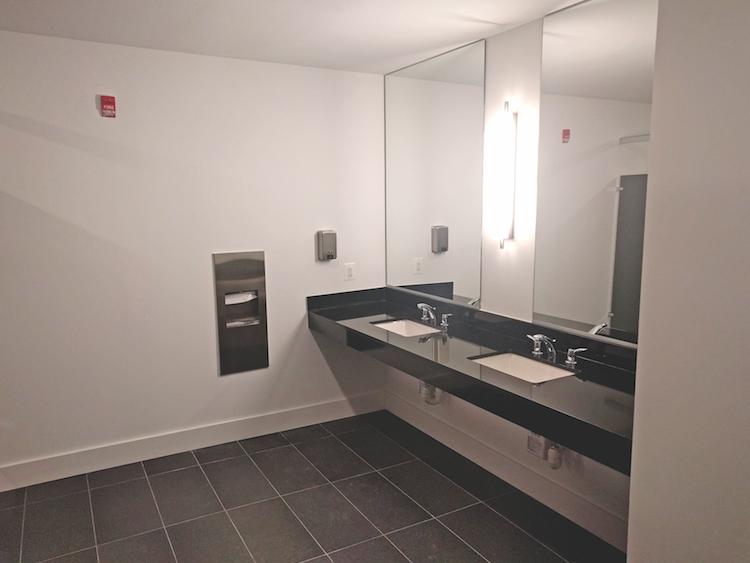 One amenity you won’t find in most apartment buildings: public toilets and water fountains in the hallways. The designers kept the originals to accommodate e-lofts businesses and their visitors. Courtesy Novus Residences
One amenity you won’t find in most apartment buildings: public toilets and water fountains in the hallways. The designers kept the originals to accommodate e-lofts businesses and their visitors. Courtesy Novus Residences
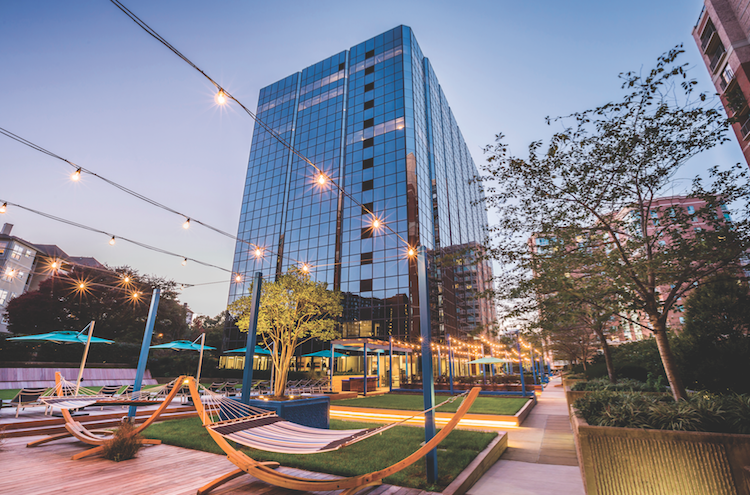 The 30,000-sf garage roof, with pergola-covered patio and outdoor dining area, can accommodate games, parties, and quiet leisure pursuits. Landworks Studio’s Mike Blier: “We used very simple materials—honest, nothing too fancy.” The deck helped meet Alexandria’s open space requirement.
The 30,000-sf garage roof, with pergola-covered patio and outdoor dining area, can accommodate games, parties, and quiet leisure pursuits. Landworks Studio’s Mike Blier: “We used very simple materials—honest, nothing too fancy.” The deck helped meet Alexandria’s open space requirement.
 The 2,000-sf club lounge is marked by formal wooden columns and soft furniture touches. Gensler’s Joanna Shin: “You can anchor yourself and work, have a lunch you’ve made in the nearby kitchen, or hold a small meeting.” Lord Aeck Sargent’s Warren Williams: “This is where visitors like to take selfies.”
The 2,000-sf club lounge is marked by formal wooden columns and soft furniture touches. Gensler’s Joanna Shin: “You can anchor yourself and work, have a lunch you’ve made in the nearby kitchen, or hold a small meeting.” Lord Aeck Sargent’s Warren Williams: “This is where visitors like to take selfies.”
Related Stories
MFPRO+ New Projects | Oct 30, 2024
BIG’s One High Line finally reaches completion in New York City’s West Chelsea neighborhood
One High Line, a luxury residential project spanning a full city block in New York’s West Chelsea neighborhood, reached completion this summer following years of delays related to investor lawsuits.
MFPRO+ New Projects | Oct 30, 2024
Luxury waterfront tower in Brooklyn features East River and Manhattan skyline views
Leasing recently began for The Dupont, a 41-story luxury rental property along the Brooklyn, N.Y., waterfront. Located within the 22-acre Greenpoint Landing, where it overlooks the newly constructed Newtown Barge Park, the high-rise features East River and Manhattan skyline views along with 20,000 sf of indoor and outdoor communal space.
Multifamily Housing | Oct 28, 2024
A case for mid-rise: How multifamily housing can reshape our cities
Often referred to as “five-over-ones,” the mid-rise apartment type is typically comprised of five stories of apartments on top of a concrete “podium” of ground-floor retail. The main criticism of the “five-over-one” is that they are often too predictable.
Adaptive Reuse | Oct 22, 2024
Adaptive reuse project transforms 1840s-era mill building into rental housing
A recently opened multifamily property in Lawrence, Mass., is an adaptive reuse of an 1840s-era mill building. Stone Mill Lofts is one of the first all-electric mixed-income multifamily properties in Massachusetts. The all-electric building meets ambitious modern energy codes and stringent National Park Service historic preservation guidelines.
MFPRO+ News | Oct 22, 2024
Project financing tempers robust demand for multifamily housing
AEC Giants with multifamily practices report that the sector has been struggling over the past year, despite the high demand for housing, especially affordable products.
Products and Materials | Oct 17, 2024
5 multifamily tech products for your next project
Multifamily housing and technological upgrades go hand-in-hand. From the rise in electric vehicle charging needs to the sophistication of smart home accessories, tech products are abound in the multifamily space.
Codes and Standards | Oct 16, 2024
North Carolina’s code policies likely worsened damage caused by Hurricane Helene
The North Carolina Legislature’s rejection of building code updates likely worsened the damage caused by Hurricane Helene, code experts say. Over the past 15 years, lawmakers rejected limits on construction on steep slopes, which might have reduced the number of homes destroyed by landslides.
MFPRO+ News | Oct 16, 2024
One-third of young adults say hurricanes like Helene and Milton will impact where they choose to live
Nearly one-third of U.S. residents between 18 and 34 years old say they are reconsidering where they want to move after seeing the damage wrought by Hurricane Helene, according to a Redfin report. About 15% of those over age 35 echoed their younger cohort’s sentiment.
Student Housing | Oct 9, 2024
University of Maryland begins work on $148 million graduate student housing development
The University of Maryland, in partnership with Campus Apartments and Mosaic Development Partners, has broken ground on a $148.75 million graduate student housing project on the university’s flagship College Park campus. The project will add 741 beds in 465 fully furnished apartments.
MFPRO+ News | Oct 9, 2024
San Francisco unveils guidelines to streamline office-to-residential conversions
The San Francisco Department of Building Inspection announced a series of new building code guidelines clarifying adaptive reuse code provisions and exceptions for converting office-to-residential buildings. Developed in response to the Commercial to Residential Adaptive Reuse program established in July 2023, the guidelines aim to increase the viability of converting underutilized office buildings into housing by reducing regulatory barriers in specific zoning districts downtown.


